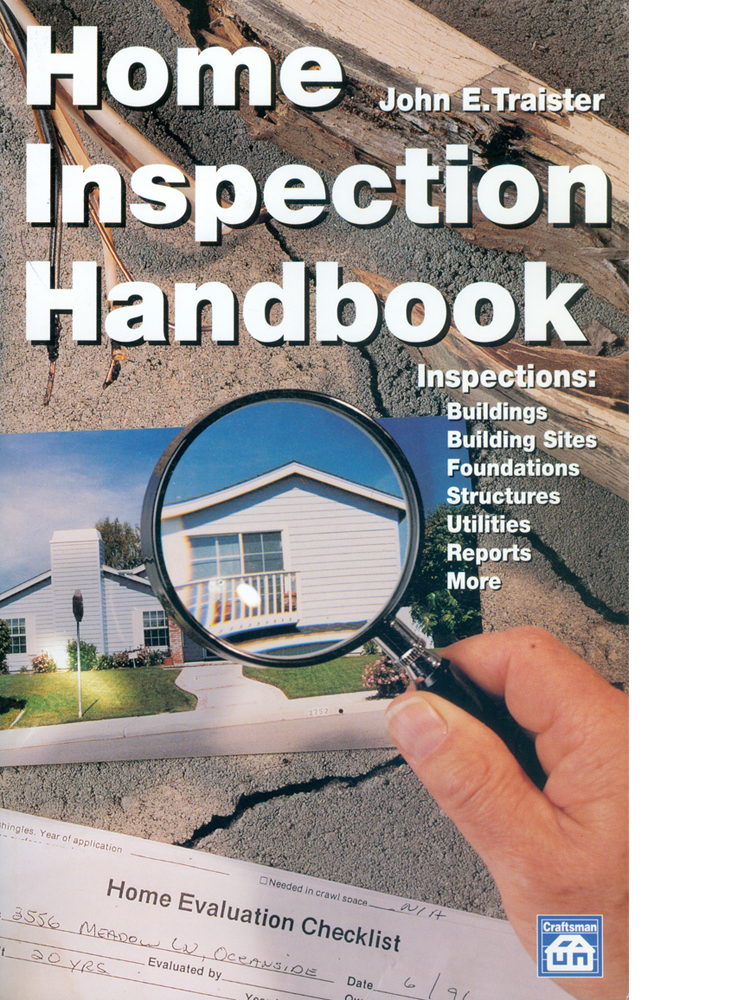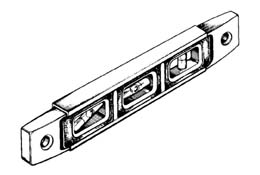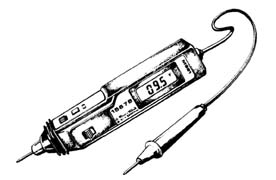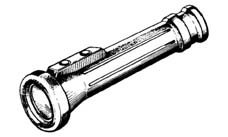Home Inspection Handbook
Every area you need to check in a home inspection – especially in older homes. Twenty complete inspection checklists: building site, foundation and basement, structural, bathrooms, chimneys and flues, ceilings, interior & exterior finishes, electrical, plumbing, HVAC, insects, vermin and decay, and more. Also includes information on starting and running your own home inspection business.
Every area you need to check in a home inspection – especially in older homes.
Twenty complete inspection checklists: building site, foundation and basement, structural, bathrooms, chimneys and flues, ceilings, interior & exterior finishes, electrical, plumbing, HVAC, insects, vermin and decay, and more.
Also includes information on starting and running your own home inspection business.
| Weight | 1.500000 |
|---|---|
| ISBN | 978-1-57218-046-8 |
| Page Count | 324 |
| Author | John E. Traister |
| Publisher | Craftsman Book Company |
| Dimensions | 5-1/2 x 8-1/2 |
Chapter 1 The Home Inspection Business, 7
Getting Organized, The Field Inspection, Meet the Owner, Energy Considerations, The Home's Utilities, Problem Areas
Chapter 2 Building Sites and Landscaping, 39
Restrictions on Land Use, Evaluating Homes, Landscaping, Inspecting Landscaping, Inspection Checklist - Building Sites
Chapter 3 Foundations, 57
Footings and Walls, Concrete Slabs, Inspecting the Foundation, Inspection Checklist - Foundations
Chapter 4 Building Structures, 71
Wood Construction, Masonry Structures, Inspecting Building Structures, Inspection Checklist - Structures
Chapter 5 Roofing, 87
Roof Styles and Design, Roofing Material, Rafters, Inspecting the Roof, Inspection Checklist - Roofing
Chapter 6 Chimneys and Flues, 113
Chimney Inspection, Fireplace Inspection, Inspection Checklist - Chimneys and Flues
Chapter 7 Interior Finishes, 127
Inspecting the Interior, Inspecting Trim and Built-ins, Ceilings
Chapter 8 Exterior Finishes, 151
Wood Siding, Miscellaneous Wall Siding, Masonry Facings, Surface Coatings, Inspecting the Home's Exterior, Inspection Checklist
Chapter 9 Insects, Vermin and Decay, 171
Termites, Vermin, Wood Decay and Radon Gas, Inspecting the Home for Pests and Rot, Inspection Checklist
Chapter 10 Electrical Systems, 187
The Electrical System, The National Electrical Code, Inspecting the Electrical System, Inspection Checklist
Chapter 11 Heating, Ventilating and Air Conditioning, 227
Types of Heating Systems, Basic Air-Conditioning Concepts, Inspecting the HVAC System, Inspection Checklist
Chapter 12 Plumbing Systems, 253
The Basic System, Hot Water Systems, Indirect Water Heating, Inspecting the Plumbing, Inspection Checklist - Plumbing
Chapter 13 Operating Techniques, 275
Checklists for Going Into Business, Getting Started ... Right! Cost Accounting, Public Relations, Advertising
Chapter 14 Preparing Reports, 297
Types of Reports, Practical Applications
Index, 317
Preface
Home inspection encompasses a fascinating world with many opportunities. Few businesses or professions offer as much opportunity, with minimal investment, as home inspection.
A little more than a decade ago, fewer than 5% of the homes sold in the United States were inspected or appraised by professional home inspectors. Most lending institutions required only that an officer of the firm briefly look at the property and note its general condition. However, by 1990, over 35% of home mortgage loans required some form of inspection. Within five years (by the year 2000), it is estimated that 90% of all federally-insured lending institutions will require a complete inspection before granting any loans.
Inspection requirements became mandatory because of the economic issues facing the United States in the 1980s and the financial industry's dilemmas. Problems in the savings and loan industry forced bank examiners to scrutinize every loan record and application. Most banks adopted their own policies requiring approved inspectors and appraisers to carefully examine property for all home mortgages. Insurance companies have recently required an inspection of property before they will issue policies. Even home buyers, wary of rising costs and rates, hired home inspectors to thoroughly investigate property before making a purchase.
Thousands of existing homes are sold each year. Billions of dollars are spent on new construction that takes place on a continuing basis.
Thousands of loans are refinanced each year. Most of these transactions eventually need the services of a professional home inspector.
Many home inspectors also appraise all types of property - rural property, tract developments, and commercial property. Doing so broadens the home inspector's opportunities for profitable employment with banks, real estate firms, savings and loan companies, government-guaranteed loan organizations, and others.
This book is designed to review the way buildings are designed and constructed, which areas of buildings should be inspected, and how to inspect them. Suggestions are then given to help prepare an inspection report; reports designed to please and meet the specifications of lending institutions and other organizations requiring home- inspection services. In fact, the data presented in this book will prove invaluable on practically every home inspection project encountered.
John E. Traister
1995
Chapter One
The Home Inspection Process
The best way to organize an on site inspection is to use a checklist. Such lists must remain flexible and should be amended each time an inadequacy is discovered in the field. This book has included various checklists for your use as guides. However, they are not gospel. They should be amended and customized to suit your particular circumstances.
Some of the information included in this chapter touches upon detailed information outlined in other chapters. It is designed as an overview of home-inspection procedures required on each job, and to help you visualize a sense of movement through a building and on the surrounding grounds. As a complement to this, partial checklists have been developed to help in organizing your own procedures. Additional chapters will reinforce these inspection techniques.
GETTING ORGANIZED
One of the key words for a successful inspection business is organization. While this chapter material is indeed helpful in learning the fundamentals, it is no substitute for the personal intuition and working methods that come through experience. This book will lay a solid foundation for you. It will then be up to you to apply what you have learned ... the checklists contained herein are one of the "tools" that will help you. You should customize your own lists in a way that will be comfortable for you and fit your working method as well as the particular clientele that you are marketing.
The Job Checklist
When a client calls, or you make a contact from a referral, get the correct and complete name, address and phone. This is basic. Pertinent data might include the following:
- Date
- Name
- Address
- Phone
- Billing address
- Address of property to be inspected
- Present owner
- Directions to site
- City/County zoning of site
- Your proposed method of billing (hourly or by job)
You should also be prepared to give potential customers the approximate amount of your charges before beginning the inspection. The fee that you normally charge may differ greatly from what the customer thinks the job is worth. An inspection-form head should look approximately like the one in Figure 1-1.

Figure 1-1 A simple home inspection report head
Site Appointment
The following information should also be obtained at an early date:
- Date of appointment
- Time of appointment
- Who will attend
- Address
- Approximate mileage from inspector's office
- Equipment to be taken to site
All of your checklists are particularly important when discussing a job with a client, either over the phone or in your office. Referral to a checklist will show the client how thorough and organized you are - giving him or her confidence in hiring you - much the same as an airline pilot goes through an extensive checklist before each and every flight.
Inspector's Equipment
An inspector will need to have various pieces of equipment in order to properly evaluate a building. A level is a necessity. Look to purchase a high-quality level that is short enough to carry conveniently. Keep in mind, however, that the shorter the level, the less accurate it is. Levels can be quite sophisticated; some even have a digital readout of degrees slope. More than likely, a simple bubble level will suffice. See Figure 1-2.
Left: Figure 1-2 A small bubble level will usually
suffice for most home inspection jobs.
Right: Figure 1-3 An electrical testing instrument is
essential for testing electrical circuits and apparatus.
Various electrical testing instruments will be essential. Your basic testing instrument should be a voltage tester, used to determine what wires or equipment are "live." Many home inspectors purchase a combination volt-ohm-ammeter such as the one shown in Figure 1-3.
Measuring tape of good quality with a capacity of at least 100' is recommended (don't use electronic sonic devices - keep things simple and use a manual tape measurer). A shorter tape measure (Figure 1-4) that may be carried on your belt is also highly recommended for measuring shorter distances such as the width of doors and windows, depth of cabinets, ceiling heights, and the like.
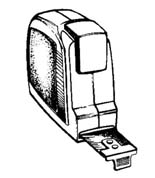
Left: Figure 1-4 You will need at least a 100'
tape to
measure the outside perimeter of the home, but a shorter tape
that can be clipped to your belt will also be handy
for the majority of your measurements.
Right: Figure 1-5 Inspectors should carry two flashlights,
as well as extra batteries and bulbs for each.
A flashlight is absolutely necessary for all home inspection jobs. In fact, you should have at least two of them, along with spare batteries and bulbs. A flashlight is necessary for inspecting under crawl spaces, under porches for structural defects or insects, in dark corners of basements at an electric panel, and a host of other uses. You don't need an extremely powerful one; the one shown in Figure 1-5 should be adequate.
Always keep a complete set of screwdrivers in your car. In general, a small and medium screwdriver with wedge-shaped blades and one Phillips head screwdriver will suffice for most of your needs. The ones shown in Figure 1-6 are good choices.
Figure 1-6 Screwdrivers will be useful on every job.
You might also want to carry an ice pick for probing into
suspicious timbers for decay or termite damage.
The medium-size screwdriver will be used for removing panel covers on appliances and electric panels. It is also good for poking into suspicious wood members for signs of dry rot and termites - although many home inspectors prefer an ice pick or scratch awl for this latter operation. The smaller screwdriver is useful for removing the plates from wall switches and duplex receptacles so that the wiring and devices may be checked. You will also find many other uses for a set of screwdrivers.
Other necessary tools include an inspection mirror, a dial thermometer, binoculars (for a close-up look at certain parts of the house, like the roof, that are difficult to get near), and a ladder (a folding 6' step ladder will serve most of your needs). Of course, you should also have at least two pens (black or blue), several business cards, paper for taking notes, graph paper for making sketches of the home's floor plan, and a clipboard.
If you have agreed to perform a radon test, make sure that you have some radon detection units in your car. Spot testing can be done with either a charcoal canister or an alpha track device (the tab test costs between $25 and $50.) Get more information from the National Association of Home Builders (NAHB) and the Environmental Protection Agency (EPA) of the Federal government. Usually the charge for the radon test is added to the cost of the inspection.
There are other tools that will come in handy from time to time. For example, an inexpensive compass will indicate in which direction the house is facing; gloves to protect your hands from dirt and splinters; roofers boots (non-slip soles) if you are required to walk on the building roof; camera and film to record the appearance of the home, including close-up details. Here's our job-site equipment checklist so far (again, revise it to suit your needs):
- Radon detector
- Screwdrivers
- Electrical testing instruments
- Moisture meter
- Level
- Tape
- Calipers
- Flashlight/miners hat light
- Magnifying glass
- Binoculars
- Profile gauge
- Gloves
- Camera and film
- Roofers boots (non-slip soles)
- Fold-up ladder
- Compass
- Hand mirror
A brief description of some these tools is in order. A moisture meter is useful for determining the moisture content of timber and in areas of the house that seem to be overly damp. A magnifying glass can be used (for one) to distinguish between termites and flying ants. The hand mirror, used in conjunction with a flashlight, can be used to explore the inside of wall partitions.
Dress
Home inspectors are in constant contact with the public. To be successful, always present yourself as a professional. Nothing projects this image better than your appearance. When you show up for the inspection, be sure that you are neat and clean. If you get out of your car in jeans and a T-shirt, your client will think that you don't take your job seriously. Appropriate attire for men include slacks, a sport coat, a dress shirt, and a tie. Women should wear slacks, a blouse, and a blazer. To allow more freedom for movement, you can remove your coat when you begin the inspection.
Wear flat shoes with a rubber sole (not tennis shoes). The rubber sole is necessary for safety. It will provide traction and help prevent electrical shock. Keep your shoes clean and polished. Keep a raincoat and a set of coveralls stored in your car. Store them in a place where you won't stack anything on top. A wrinkled or stained raincoat or coveralls do not present a professional appearance.
THE FIELD INSPECTION
As you approach the home that you will be inspecting, observe the lay of the land. Is the area on high ground or does it seem to be low-lying? This may seem like an insignificant question, but sites on high ground will generally have fewer storm-drainage problems and therefore will tend to have usable dry basements. The ideal location for a house is on a large knoll on the lot with drainage leading away from the house in all directions. See Chapter 2. Note the spacing of street storm drains (usually built adjacent to the sidewalk curbing in the street). If there is a lot of dirt, leaves and dirty sticks and trash at the drain, there might be a problem with poor drainage or a drain that backs up into the street. This may be the first indication of problems at the building site.
If inspecting a rural home, look for low-lying swampy areas where water might be standing, or where water stands most of the time. These areas can be detected by thin or non-existent grass growth, mud holes, or a brownish-gray discoloration of the surrounding low-lying plants. Willow trees at the site also indicate high ground moisture.
If you ever wanted to enter the home inspection business yet weren't sure where to start, let this book show you where to begin.
If you're already involved in home inspection projects, you'll find information in this book that you'll want to refer to on a daily basis. Here you'll find what areas you need to check in a typical home inspection, along with exactly where you should look, and surprises you're likely to find - especially in older homes.
Dozens of forms and checklists are included, as well as solid information on what you need to inspect building sites and landscaping, foundations, structures, roofing, chimneys and flues, interior and exterior finishes, electrical systems, HVAC systems, and plumbing systems.
You'll even be shown how to fill out and prepare home inspection forms and reports required by owners and lending institutions

